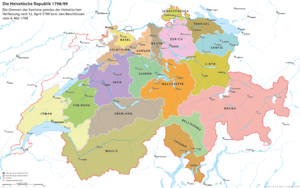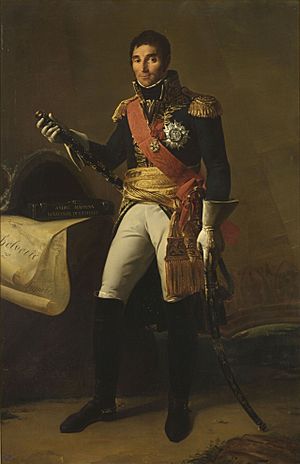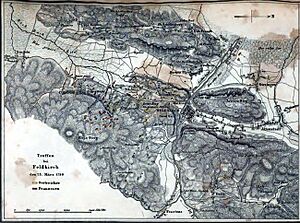Battle of Feldkirch facts for kids
Quick facts for kids Battle of Feldkirch |
|||||||
|---|---|---|---|---|---|---|---|
| Part of War of the Second Coalition | |||||||
 The Ill River runs through rugged terrain near Feldkirch. |
|||||||
|
|||||||
| Belligerents | |||||||
| Commanders and leaders | |||||||
| Strength | |||||||
| Casualties and losses | |||||||
| 900 | 1,500–3,000 | ||||||
The Battle of Feldkirch happened on March 23, 1799. It was a fight during the War of the Second Coalition. French forces, led by General André Masséna, attacked Austrian soldiers. The Austrian troops, led by General Franz Jellacic, were fewer in number but held strong positions.
The battle took place in the town of Feldkirch, Vorarlberg, in Austria. The Austrians successfully defended their fortified lines against all French attacks. The fighting lasted until nightfall. This defeat, along with other French losses in southern Germany, made Masséna's army switch to defending instead of attacking.
Before this battle, in January 1798, a French army had entered Switzerland. They forced Switzerland into an alliance, which led to some local uprisings. By early 1799, Masséna was in charge of the French Army of Helvetia (the army in Switzerland).
The French had won some battles earlier in March at Maienfeld, Chur, and Feldkirch. Masséna was ordered by his commander, Jean-Baptiste Jourdan, to attack Feldkirch again. He used troops under Nicolas Oudinot for this attack. However, Jourdan's army suffered defeats at Ostrach and Stockach. These losses soon forced the French to pull back.
Contents
Why the War Started
France Takes Over Switzerland
The French government, called the French Directory, said they invaded Switzerland because the Swiss were treating people badly in one area, Vaud. But the real reason was probably that France wanted to get the gold and money from the Swiss treasury in Bern.
Guillaume Brune was put in charge of the Army of Helvetia. He marched north with a division from the Army of Italy starting January 1, 1798. At the same time, Balthazar Alexis Henri Schauenburg led 15,000 soldiers from the Army of the Rhine towards Bern from the north.
While this was happening, fake talks were held to trick the Swiss. On February 5, 1798, Brune officially took command of both divisions. They entered Bern on March 5 after some small fights.
On March 8, 1798, Brune was sent to lead the Army of Italy. Schauenburg became the new army commander. The French took 10 million francs in cash and gold. Three million of this money helped pay for Napoleon Bonaparte's French campaign in Egypt and Syria. They also took many cannons and mortars.
Even though France and Switzerland became allies on August 19, 1798, many Swiss people were unhappy with French control. French soldiers had to put down revolts in places like Valais. Schauenburg was a good organizer. On December 11, he handed over command to André Masséna. At this time, the Army of Helvetia had 24,000 experienced soldiers.
By invading Switzerland, France accidentally created a new way for their enemies to attack them. France had strong forts along its borders with Belgium and Germany. But along the Swiss border in the Jura Mountains, there were only a few forts. A French leader, Lazare Carnot, noted that when Switzerland was neutral, France didn't need to worry about that border. But with Switzerland involved in the war, France had to send 40,000 soldiers to either control the country or guard the border.
War Breaks Out
France's actions in Switzerland, Ottoman Egypt, Holland, Malta, and other places led to the formation of the Second Coalition against them. The United Kingdom joined with Austria, the Russian Empire, and other countries.
The French government realized that war was coming. They called up 200,000 new soldiers. Besides Bonaparte's army in Egypt, France had five other armies. These armies were not very well equipped.
- Masséna was in Switzerland with 30,000 men.
- Jean-Baptiste Jourdan was in Alsace with 37,000 troops.
- Barthélemy Louis Joseph Schérer had 58,000 men in northern Italy.
The French Directory ordered Masséna to capture the Vorarlberg and Graubünden (Grisons). He was then to move towards the County of Tyrol. Jourdan was told to cross the Rhine River and meet up with Masséna's army. Schérer was to connect with Masséna's right side while fighting the Austrians near Verona.
The Austrians also had many soldiers ready:
- 75,000 men in northern Italy under Paul Kray.
- 18,000 troops in the Tyrol led by Count Heinrich von Bellegarde.
- 26,000 soldiers in the Vorarlberg and Graubünden under Friedrich Freiherr von Hotze.
- 80,000 men led by Archduke Charles, Duke of Teschen near the Lech River in southern Germany.
The Battle of Feldkirch
Early Fights at Chur and Feldkirch
In February, Claude Lecourbe's French division was on Masséna's right side. Charles Antoine Xaintrailles's division, which included Nicolas Oudinot's brigade, guarded the Rhine River. The Austrian General Hotze had 20,000 troops at Bregenz and Feldkirch. Another Austrian general, Franz Xaver von Auffenberg, had 4,500 men at Chur.
Even though war hadn't been officially declared, Jourdan told Masséna he would cross the Rhine on March 1. So, Masséna launched an attack across the Rhine on March 6 at Luziensteig. This place was between Hotze and Auffenberg's positions. The Austrian defenses were strong, but the French finally captured the area that evening. The French had 5,000 soldiers and lost 300. The Austrians lost about 1,450 soldiers and 12 cannons.
On March 7, Masséna turned south and attacked Auffenberg at Chur. The French surrounded the Austrians. Some reports say Auffenberg lost 3,000 prisoners and 16 cannons. The French lost only 100 soldiers.
Meanwhile, Oudinot's brigade crossed the Rhine and moved towards Feldkirch. Hotze attacked Oudinot outside Feldkirch. The battle was very close until Jean Thomas Guillaume Lorge arrived with more French soldiers. Towards evening, Oudinot led a cavalry charge that pushed Hotze back into the town. The French captured 1,000 Austrian soldiers and four cannons.
The Main Battle of Feldkirch
Lecourbe's 10,000-man division began a difficult campaign in the Engadine valley. By March 12, Lecourbe reached the upper Inn River. This campaign separated Lecourbe from the rest of the French army.
On March 9, 1799, the French Directory decided that having many separate armies was not a good idea. They put Masséna under Jourdan's command. Masséna was very angry and offered to resign on March 16. But the government insisted, and Masséna finally agreed to stay. This situation might have made Masséna more eager to attack in the following days.
By March 19, Jourdan's army was getting closer to Masséna's. Jourdan asked Masséna to meet his army at Bregenz. On March 20, Archduke Charles ordered Hotze to send 10,000 troops from Vorarlberg to reinforce his army.
Masséna planned to have Xaintrailles pretend to attack Bregenz. Then, Masséna's main force would strike Feldkirch. Masséna had studied the Austrian defenses, which were well-dug in. But he thought Hotze's absence gave him a chance to win. Oudinot had suggested attacking Feldkirch as early as March 15.
On March 22, Masséna received an order from Jourdan to attack Feldkirch. Masséna decided to attack a day earlier, on March 23, 1799. This meant he lost the benefit of the fake attack on Bregenz. The attack was launched in four groups, with Oudinot leading one and Masséna leading another.
Feldkirch was defended by Franz Jellacic. He was known as a capable leader with a strong fighting spirit. The town was on the Ill River. It was protected by a line of defenses across the main road, with a second line behind it. The sides were guarded by small forts and barriers made of fallen trees. Jellacic had 5,500 soldiers, including infantry battalions and some cavalry and local militia.
The French attack on the far left crossed the Ill River early in the morning. It was supposed to go around Jellacic's defenses, but it was pushed back. The next group attacked the Blasenberg hill but was also defeated. A third group attacked Saint Michael's Wood and met the same fate.
Masséna sent 12 battalions (large groups of soldiers) charging up the main road. A smaller force tried to go around the side of the defenses. This flanking force made some progress but was eventually stopped. Jellacic used his smaller force very effectively. Masséna's main attack from the front failed. Jellacic's men launched a final counterattack that pushed the French back. At first, the French captured about 500 prisoners and seemed close to winning. But the strong Austrian fire and even rocks thrown at them eventually forced them to retreat.
What Happened Next
The Austrians lost about 900 soldiers killed, wounded, or missing. The French lost between 1,500 and 3,000 soldiers.
On March 24, Masséna learned that Jourdan had been defeated by Archduke Charles at the Battle of Ostrach on March 21. Jourdan's army was retreating. This meant the Battle of Feldkirch had been fought for nothing. Jourdan's Army of the Danube was defeated again at the Battle of Stockach on March 25.
With Jourdan's army retreating, Archduke Charles could easily attack Zürich. So, Masséna ordered Lecourbe to leave the Engadin valley. On April 5, Masséna took over command of the Army of the Danube from Jourdan. He gave command of the Army of Helvetia to Mesnard and left for Strasbourg.
For his brave actions, General Jellacic received a special award, the Knight's Cross of the Military Order of Maria Theresa, on April 6, 1799. He was later promoted to a higher rank.
Images for kids










